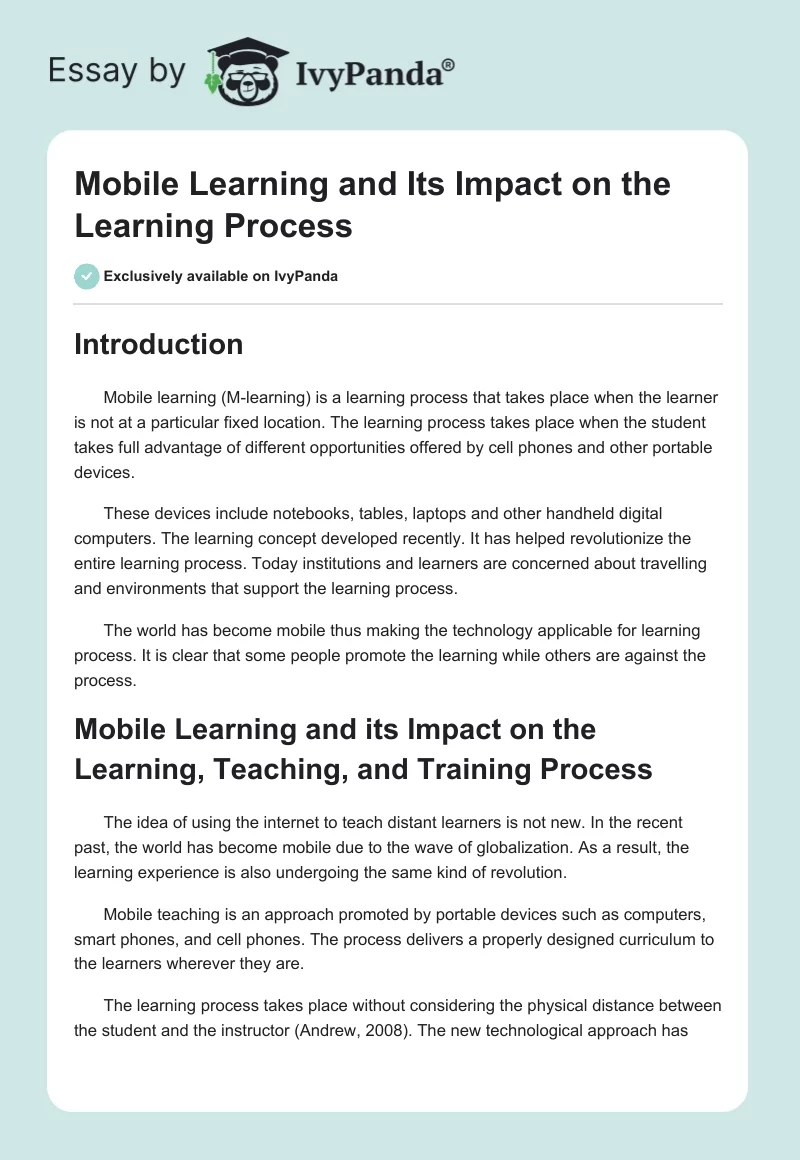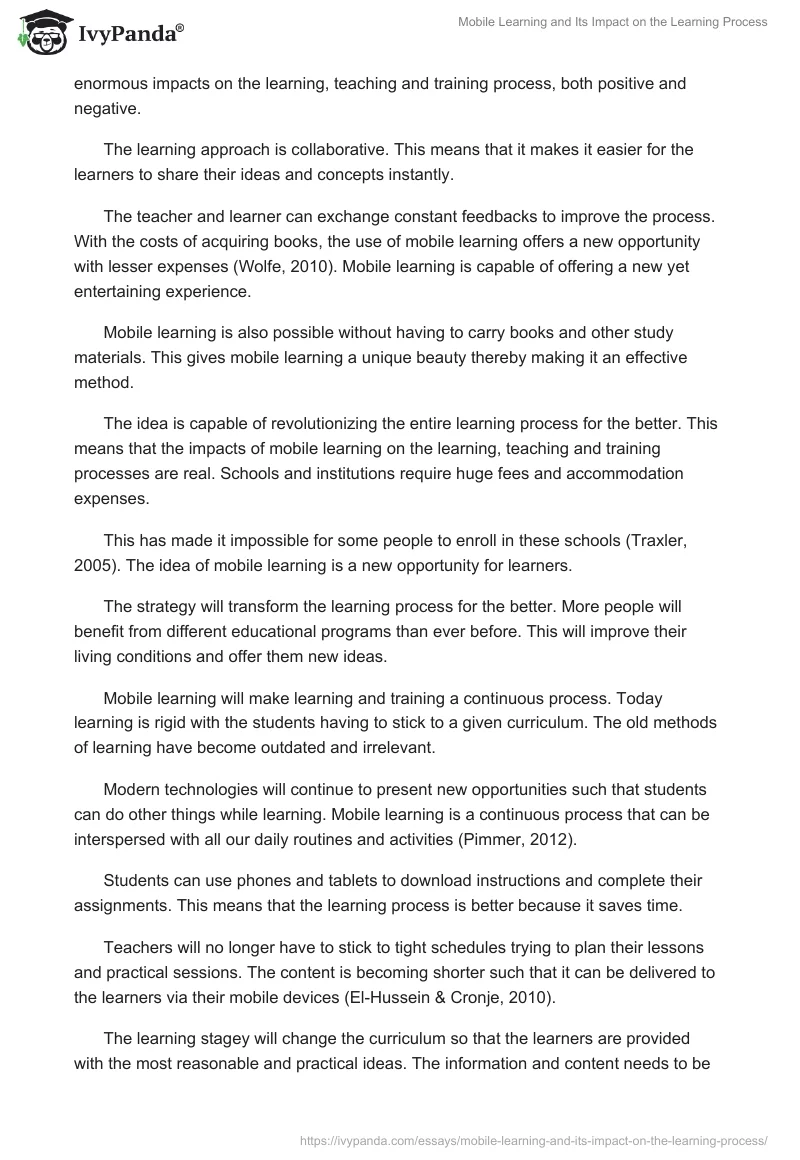Introduction
Mobile learning (M-learning) is a learning process that takes place when the learner is not at a particular fixed location. The learning process takes place when the student takes full advantage of different opportunities offered by cell phones and other portable devices.
These devices include notebooks, tables, laptops and other handheld digital computers. The learning concept developed recently. It has helped revolutionize the entire learning process. Today institutions and learners are concerned about travelling and environments that support the learning process.
The world has become mobile thus making the technology applicable for learning process. It is clear that some people promote the learning while others are against the process.
Mobile Learning and its Impact on the Learning, Teaching, and Training Process
The idea of using the internet to teach distant learners is not new. In the recent past, the world has become mobile due to the wave of globalization. As a result, the learning experience is also undergoing the same kind of revolution.
Mobile teaching is an approach promoted by portable devices such as computers, smart phones, and cell phones. The process delivers a properly designed curriculum to the learners wherever they are.
The learning process takes place without considering the physical distance between the student and the instructor (Andrew, 2008). The new technological approach has enormous impacts on the learning, teaching and training process, both positive and negative.
The learning approach is collaborative. This means that it makes it easier for the learners to share their ideas and concepts instantly.
The teacher and learner can exchange constant feedbacks to improve the process. With the costs of acquiring books, the use of mobile learning offers a new opportunity with lesser expenses (Wolfe, 2010). Mobile learning is capable of offering a new yet entertaining experience.
Mobile learning is also possible without having to carry books and other study materials. This gives mobile learning a unique beauty thereby making it an effective method.
The idea is capable of revolutionizing the entire learning process for the better. This means that the impacts of mobile learning on the learning, teaching and training processes are real. Schools and institutions require huge fees and accommodation expenses.
This has made it impossible for some people to enroll in these schools (Traxler, 2005). The idea of mobile learning is a new opportunity for learners.
The strategy will transform the learning process for the better. More people will benefit from different educational programs than ever before. This will improve their living conditions and offer them new ideas.
Mobile learning will make learning and training a continuous process. Today learning is rigid with the students having to stick to a given curriculum. The old methods of learning have become outdated and irrelevant.
Modern technologies will continue to present new opportunities such that students can do other things while learning. Mobile learning is a continuous process that can be interspersed with all our daily routines and activities (Pimmer, 2012).
Students can use phones and tablets to download instructions and complete their assignments. This means that the learning process is better because it saves time.
Teachers will no longer have to stick to tight schedules trying to plan their lessons and practical sessions. The content is becoming shorter such that it can be delivered to the learners via their mobile devices (El-Hussein & Cronje, 2010).
The learning stagey will change the curriculum so that the learners are provided with the most reasonable and practical ideas. The information and content needs to be applicable in our real-life world. These changes are becoming common due to the continued development of mobile learning.
Mobile learning will change the nature of contemporary learning practices (Traxler, 2005). This will make learning easier and deliver only the relevant information to the students.
The other possible impact of mobile learning on the teaching and training process is that it might only deliver new ideas to the learners. The world has developed such that new ideas and concepts have become very common.
With mobile learning, chances are very high that the process will consider the need to deliver the latest ideas and basic information to the learners. The outcomes of the learning experience should be able to benefit the learner (El-Hussein & Cronje, 2010).
That being the case, mobile learning will be delivering the latest ideas and information to the learners. This means that the world will revolutionize and develop faster.
Most of the current learning processes deliver outdated and restricted information to the learners. Mobile learning is a new opportunity to deliver new information to different learners. The use of mobile learning is an approach that can improve the content delivered to the learners.
The student can rely on the information and use them during the learning process. The approach will also reduce the complexity of learning materials. With a small phone, an individual can get different instructions and topics that constitute the course or subject.
The use of mobile learning is capable of providing new ideas and solutions to different learners (Traxler, 2005). This explains why many people consider mobile learning as a new approach that can help to improve the learning process. This will ensure more people benefit from the learning experience.
In the past, teachers used to teach, train and guide the learner in a classroom setting. Some students did not even participate in the classroom activities. With mobile learning, teachers and learners will have to share and trade their roles. The teachers will exchange views and feedbacks with the learners.
This will make the learning process successful and ensure it benefits the learners equally. The teachers’ schedule will change for the better. They will only be required to send the information and course materials to the learners (El-Hussein & Cronje, 2010).
After receiving the materials, the learners will study and complete the assignments given to them. From the above discussion, it is agreeable that mobile learning is a new technological idea that will have positive impacts on the learning, training and teaching process.
The learners will get much yet useful information via their handheld mobile devices. Mobile learning will reduce the duties and roles of the teachers while at the same time delivering the best to the learners (Liang, 2007). This makes mobile learning an effective approach towards learning.
However, some experts have indicated that mobile learning has some negative impacts. Mobile learning is technological approach that might have negative impacts on the learning and training experience. This is because there are some people who are computer illiterate and unable to use these devices.
This means that these people cannot benefit from the learning process. A proper learning system should be affordable by majority of people (Andrew, 2008). The use of mobile learning will affect the entire learning and training process because only a few people will benefit from the practice.
Many people criticize mobile learning because it affects the role of learning as a social practice. The classroom setting is favored because it helps improve communication and interactional skills. A teacher should know how to pass these skills to the learner during the teaching practice.
Mobile learning renders the duties of the teacher ineffective. Although m-learning can promote better educational practices, it also affects the goals and objectives of education. This explains why many people are against mobile learning.
Experts have expressed their concern that we should go back to the traditional learning process (Traxler, 2005). The content delivered to the learner is also summarized and might not be clearly understood. This makes the process ineffective for learners because they have different academic capabilities.
Conclusion
Mobile learning is the learning process that takes place when the student is far from the teacher. The process is revolutionary because it brings new approaches to the learning practice. The approach is making it easier to deliver educational skills and ideas to different learners wherever they are.
The process is done at a lesser costs and expenses. This discussion has indicated that mobile learning is changing the entire learning and training process. Teachers are not expected to stick to tight schedules and lesson plans.
The learning process is relevant because it addresses most of the challenges faced in schools and other learning institutions. However, the use of mobile learning affects the entire learning and training process because only a few people benefit from the practice.
References
Andrew, K. (2008). Models for interdisciplinary mobile learning. New York: McGraw Hill.
El-Hussein, M. & Cronje, J. (2010). Defining Mobile Learning in the Higher Education Landscape. Educational Technology & Society, 13(3), 12–21.
Liang, M. (2007). Investigating mobile learning. Tokyo: Oxford Press.
Pimmer, C. (2012). Word-Based Mobile Learning: Concepts and Cases. New Jersey: Prentice Hall.
Traxler, J. (2005). Mobile Learning: A handbook for educators and trainers. New York: Longman.
Wolfe, C. (2010). Learning and teaching on the World Wide Web. London: Academic Press.


